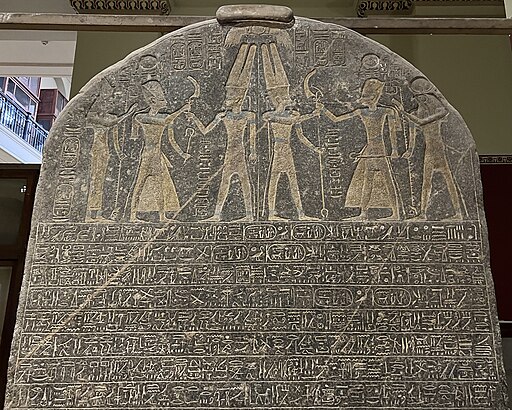
Few discoveries have been as important to understanding early Israel’s history as the Merneptah Stele. This Egyptian monument, created around 1208 BCE, contains the earliest known reference to “Israel” outside the Bible — confirming the existence of Israel in Canaan by the late 13th century BCE.
🏺 Discovery and Historical Context
The Merneptah Stele was discovered in 1896 by British archaeologist Flinders Petrie in the mortuary temple of Pharaoh Merneptah at Thebes (modern-day Luxor, Egypt). Standing over seven feet tall and inscribed in hieroglyphs, this black granite monument celebrates Merneptah’s military triumphs — especially his victories over Libya and several peoples of Canaan.
Now displayed in the Egyptian Museum in Cairo, the stele was originally composed as a royal victory hymn praising the Pharaoh’s conquests. Yet one line near the end of the inscription has captivated biblical historians for more than a century:
“Israel is laid waste; its seed is no more.”
This single reference marks the first known mention of “Israel” in any ancient inscription, predating the earliest biblical manuscripts by centuries.
🏜️ Context Within Egyptian History
Pharaoh Merneptah was the 13th son and successor of the great Rameses II (Ramses the Great), ruling Egypt from roughly 1213–1203 BCE. His reign came at the height of Egyptian power, yet during a time of increasing threats from foreign groups pressing Egypt’s borders.
The Merneptah Stele celebrates his campaign into Canaan following Egypt’s victory over Libya. The inscription lists several conquered cities and peoples:
“Canaan is plundered with every evil;
Ashkelon is carried off; Gezer is captured;
Yanoam is made non-existent;
Israel is laid waste; its seed is no more.”
What makes this list remarkable is that Israel is not described like the surrounding city-states (Ashkelon, Gezer, Yanoam). Instead, the inscription uses a sign for a people, not a land or city, showing that the Egyptians saw Israel as a tribal or ethnic group. This view aligns with the biblical record, which describes Israel as a people not yet settled in a kingdom.
📜 Biblical and Archaeological Significance
The Merneptah Stele pushes the earliest historical attestation of Israel back to around 1208 BCE, aligning with the period of the biblical Judges and possibly the late settlement period in Canaan.
While the Bible describes Israel’s emergence in the land following the Exodus, the stele confirms that a people called Israel were known to Egypt by the late 13th century — living somewhere in Canaan.
Archaeologically, this supports a key historical reality:
- By this time, Israel existed as a distinct socioethnic entity.
- They were significant enough to be mentioned in Egypt’s royal propaganda.
- Their presence was recognized among the city-states of Canaan long before the rise of the Israelite monarchy (~10th century BCE).
⚖️ Scholarly Interpretation
Scholars widely agree on the authenticity and translation of the “Israel” line, though debate continues about the precise location or nature of this group. Some view it as referring to an early tribal coalition in the central hill country, consistent with settlement patterns found in Iron Age archaeology. Others interpret it more broadly as a semi-nomadic people still forming their identity.
Despite these nuances, nearly all experts agree that this inscription provides definitive evidence of Israel’s existence by around 1200 BCE. It has become a cornerstone of biblical archaeology and early Israelite studies.
🏛️ Why the Merneptah Stele Matters
The Merneptah Stele bridges the gap between Egyptian history and biblical tradition, demonstrating that the people of Israel were not a later invention or mythic construct.
It stands as:
- The earliest mention of Israel outside the Bible.
- A chronological anchor placing Israel in Canaan before the monarchy.
- A testament to Egyptian awareness of emerging peoples in the Levant.
In many ways, this inscription marks the very beginning of Israel’s historical record. Carved by a Pharaoh rather than a Hebrew prophet, it is the words of an adversary that unintentionally affirm the existence of the people Scripture exalts.
📚 References
- Petrie, W. M. Flinders. Six Temples at Thebes, 1896. London: Egypt Exploration Fund, 1897. Available here.
- This is the original primary source report documenting the discovery and find-site of the Merneptah Stele during archaeological excavations at Thebes.
- Hasel, Michael G. “Israel in the Merneptah Stela.” Bulletin of the American Schools of Oriental Research 296 (1994): 45–61. Available here.
- A peer-reviewed academic analysis detailing the textual and archaeological significance of the Merneptah Stele’s mention of “Israel” in the late 13th century BCE.
- Biblical Historical Context. “The Merneptah Stele: Beyond Apologetics.” Biblical Historical Context, 2022. Available here.
- An online essay that uses the stele’s boastful language of annihilation to discuss the concept of hyperbole in both ancient Egyptian propaganda and biblical texts.
- Image Credits: Merneptah Stele (cropped) — Photo by Onceinawhile, Wikimedia Commons, CC BY-SA 4.0

Leave a Reply